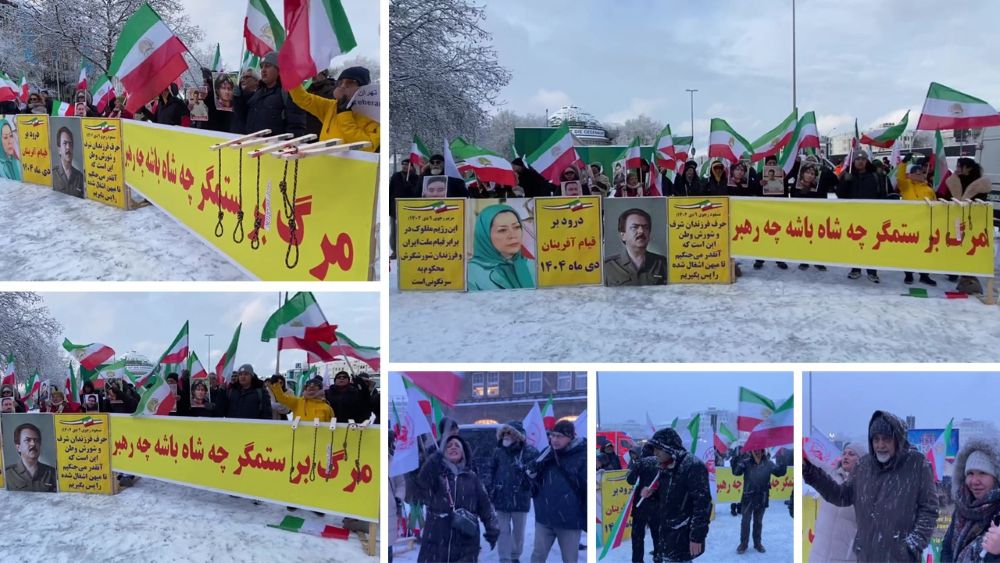Iran’s protests in the second week of February 2019
In answer to the regime’s masquerade of Feb. 11’s march at the anniversary of the anti-monarchy revolution, celebrating that it has last one more year, the people of Iran held more than 50 protest gatherings and strikes at the second week of February, throwing a hard blow at the regime and its so-called supreme leader. By this they revealed the truth about the real status of the mullahs’ regime.
Statistical report of Iran’s protests in the second week of February 2019:
There were 57 registered protests in the second week of February:
- Workers 20
- Victims of financial fraud 7
- Educators and retirees 10
- Other strata including farmers 15
- Prisoners 3
On the average, there were 8 protests a day
Iran’s protests in the second week of February were as follow:
- Workers:
- Railway workers in cities of Tabriz, Marand, Jolfa and Ajabshir went on strike to protest their unpaid wages.
- The municipal workers in the cities of Kermanshah and Sarvabad went on strike and gathered in protest against unpaid wages.
- Workers of Sufian Cement Factory staged a protest gathering for several days demanding their unpaid wages.
Plundered customers of financial institutes affiliated with the mullahs’ regime:
During last week, plundered customers of Caspian Credit Institution affiliated with the IRGC (in Tehran, Rasht, and Kermanshah), Padideh Shandiz Institution (in Mashhad and Tehran), Sohanak Majlis project (Tehran), and ADAG Automobile Corporation in Tehran staged protest gathering.
Retirees:
2017 retired workers of Haft Tapeh sugarcane factory, staged a protest gathering in front of the Finance Affairs Office of the factory, for not receiving their annual retirement bonuses.
Educators:
- Educators in cities of Ardabil, Orumiyeh, Khorramabad, Sanandaj, Kermanshah, Mashhad, Shiraz, and Marivan staged a pre-announced protest gatherings to voice their discontent about the failure of the government to meet their demands and for not releasing the detained teachers.
- In Qazvin Province, teachers (deployed by the government to impoverished areas of the country but paid by the private sector) went on strike and refused to show up in their classes in the morning shift. They continued their strike in the afternoon protesting their unpaid paychecks and bonuses, rudimentary insurance plans and lack of job security. The salaries of these teachers are one fourth of the salaries of the officially employed teachers by the Ministry of Education.
Farmers:
Farmers of Dana in Kohgiluyeh and Boyer-Ahmad Province, staged a gathering protesting the distribution of Chemical fertilizers and the violations committed by the regime’s officials in that regard.
Others most important Iran’s protests in the second week of February were as follow:
– Abadan’s vendors staged protest gatherings for several days The Municipal agents have taken away their goods.
– A group of individuals taking law exams gathered in protest in front of the Majlis.
– In Orumiyeh (N.) the poultry house owners staged a protest gathering against non-payment of billions of Tomans by the Poultry Slaughterhouses, belonging to the Mostazafan Foundation, affiliated to the Supreme Leader, Khamenei.
–Conservationists along with citizens of Mazandaran Province staged a gathering to protest against selling hunting licenses for the Zaghmarz wetland.
– Wireless taxi drivers in Tehran staged a gathering in front of the Taxi Drivers Organization, to protest into inaction of the officials regarding their complaints.
– A number of unemployed youths in the city of Shush, Khuzestan Province, staged a gathering in protest to the increase in unemployment rate in the city.
Conclusion: The surge in protests of the various strata of the Iranian people indicates the popular fury against the suppressive and plundering regime ruling Iran.
The social protests against the clerical regime, which started at the end of 2017, have continued up to now. Having in mind that the economic and political situation of the clerical regime have deteriorated considerably since 2017, it is predictable that the protests in the near future will have a nationwide surge with more fundamental demands.
This heralds the end of the ruling mullahs who are caught between the hammer of people’s demands and the anvil of a dreadful economic and political situation.
This report originally published in the Our Iran website in Persian



